本文主要介紹 Gated Recurrent Unit (GRU) 和 Long Short Term Memory (LSTM) 這兩種 Recurrent Neural Network (RNN) 模型的架構及其原理。GRU 將 basic RNN 的結構加上一個 memory cell 來解決 vanishing gradients 的問題,而 LSTM 則是改進 GRU,將 basic RNN 的結構更進一步加上三個 gates 來解決 vanishing gradients 和 long-term dependency 的問題。此外,也介紹了 Bidirectional RNN (BRNN) 和 Deep RNNs (DRNN),BRNN 能夠雙向處理句子,而 DRNN 則是將 RNN 的 hidden layers 數目增加。
- 先回顧 basic RNN 的架構,在計算 a<t> 時是這樣計算
a<t>=g(Wa[a<t−1>,x<t>]+ba)
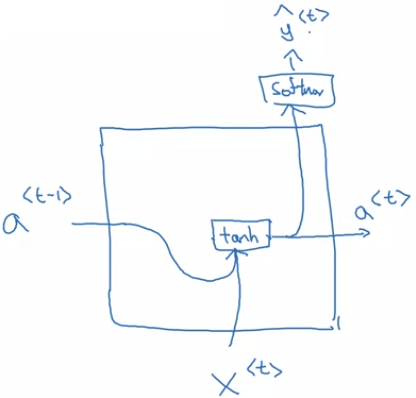 Basic single RNN
Basic single RNN- GRU 在 basic RNN 中加入一個 memory cell (c) 的概念
- 回到原本的句子,目標是讓網路可以記憶
cat 並在之後知道要使用 was- The cat, which already ate ... was full.
- 定義每一個 c<t> 會和 a<t> 相等 c<t>=a<t>
- 然後定義 c~<t> 是可能取代掉 c<t> 的候補
- c~<t>=tanh(Wc[c<t−1>,x<t>]+bc)
- 接著定義一個 Update Gate (Γu) 用來決定是否要用 c~<t> 取代掉 c<t>
- Update Gate 最好要能 output 0/1 值,1 決定取代、0 放棄取代,所以使用 sigmoid function
- Γu=σ(Wu[c<t−1>,x<t>]+bu)
- 最後用以下公式決定每個 time step 要不要更新 c<t>
- c<t>=Γu×c~<t>+(1−Γu)×c<t−1>
- 當 Γu=1 時,後面被消掉,所以 c<t>=c~<t>
- 當 Γu=0 時,前面被消掉,所以 c<t>=c<t−1>
 RNN GRU Example
RNN GRU Example- 回到 cat 的句子問題
- 在 cat 時把 c~<t>=1,Γu=1
- 此時的 c<t> 就會被設定為 1 (假設 1 代表單數、0 代表多數)
- 接著句子持續下去,每一個的 Γu 都設定為 0,避免 cat 的資訊被刷掉
- 直到 was 的 time step 出現,我們就可以用 c<t> 告訴他是 cat 要用 was
- 等到 was 結束,不會再用到這個資訊,在之後的某個地方就會設定 Γu=1 更新
- 因為使用 sigmoid 作為 Γu 的計算方式
- 使得 Γu 長期都會非常接近 0 或是 1
- 當 Γu=1 時,c<t> 就會被更新
- 當 Γu=0 時,c<t> 就會保持 c<t−1>
- 由於 c 經過很長時間依然不變,且 c 就是 a,所以也解決了 vanishing gradients
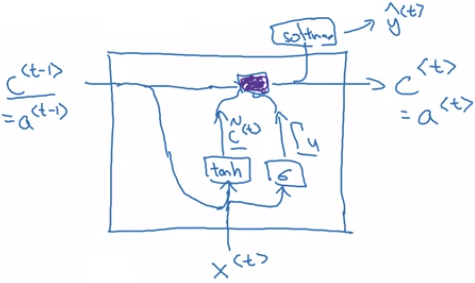 Simplified GRU
Simplified GRU- 在 GRU 的 network 中
- 先用 c<t−1> 和 x<t> 進行
tanh 得到 c~<t> - 再用 c<t−1> 和 x<t> 進行
sigmoid 得到 Γu - 然後透過紫色區塊 (就是決定是否更新) 來更新新的 c<t>=a<t>
- 最後跟一般一樣,產出 y^<t>
- 要注意的是,c<t> 可以是一個 vector
- 若是 c<t> 是一個 100 dimensional 的向量
- 那麼 c~<t>,Γu 也會是 100 dimensional
- 而更新 c<t> 的乘法就會是 element-wise 的乘法
c<t>=Γu∗c~<t>+(1−Γu)∗c<t−1>
- 以上的 GRU 是簡化過的 GRU
- 在完整的 GRU 中,會再添加一個 Relevance Gate Γr
- Relevance gate 用來表示 c<t> 和 c~<t> 的關聯性
- 我們在原本的 c~<t>
- c~<t>=tanh(Wc[c<t−1>,x<t>]+bc)
- 加入 Relevance gate
- c~<t>=tanh(Wc[Γr×c<t−1>,x<t>]+bc)
- 而 Relevance gate 的算法也很簡單
- Γr=σ(Wr[c<t−1>,x<t>]+br)
- Full GRU 的算式如下
c~<t>ΓuΓrc<t>=tanh(Wc[Γr×c<t−1>,x<t>]+bc)=σ(Wu[c<t−1>,x<t>]+bu)=σ(Wr[c<t−1>,x<t>]+br)=Γu×c~<t>+(1−Γu)×c<t−1> - LSTM 跟 GRU 長的很像,但其實 LSTM 是較早出現的架構
- LSTM 捨棄了 relevance gate,保留 update gate,並新增了 forget gate 和 output gate
- LSTM 不再讓 c<t>=a<t>,並將兩者分開來計算
c~<t>ΓuΓfΓoc<t>a<t>=tanh(Wc[a<t−1>,x<t>]+bc)=σ(Wu[a<t−1>,x<t>]+bu)=σ(Wf[a<t−1>,x<t>]+bf)=σ(Wo[a<t−1>,x<t>]+bo)=Γu∗c~<t>+Γf∗c<t−1>=Γo∗tanh(c<t>) - 首先 t~<t> 不再使用 c<t−1> 而是使用 a<t−1> 來跟著 x<t> 一起計算
- 然後依次算出 Γu,Γf,Γo
- 更新 c<t> 時,不再是兩者取一,而是將 c<t−1> 乘上 forget gate 後,加進 update 的 t~<t>
- 最終用 output gate 乘上 tanh(c<t>) 來更新 a<t>
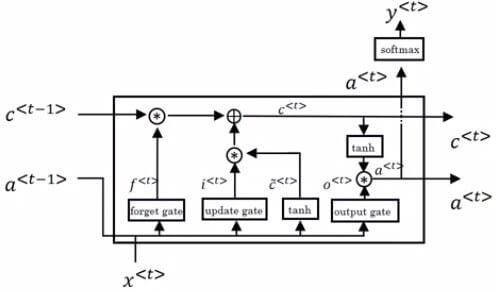 LSTM Model
LSTM Model- 接收上一層的 c<t−1>,a<t−1>
- 結合 x<t> 算出三個 gate 和 c~<t>
- 計算出這一層的 c<t>,a<t> 給下一層使用
- 算出預測值 y^<t>
- 將多個 LSTM 相連在一起就是 LSTM network
 LSTM Nets
LSTM Nets- 上面的 LSTM 的三個 gate 值只有使用 x<t>,a<t−1> 計算出來
- 但在實作上有一種方法將 c<t−1> 也帶入計算 gate 值
- 這種方法稱為 Peephole connection
- 注意點是,若 gate 是個 100 dimensional 的 vector
- 那麼 c 的第 i 個值,只會影響到 gate vector 中的第 i 個值
- 也就是 c 和 gate 的關係是 1 對 1 的
- 跟 GRU 在更新 gate 是不一樣的
ΓuΓfΓo=σ(Wu[a<t−1>,x<t>,c<t−1>]+bu)=σ(Wf[a<t−1>,x<t>,c<t−1>]+bf)=σ(Wo[a<t−1>,x<t>,c<t−1>]+bo) - 前面也說過,單方向的 RNN 會無法處理一些問題
- 例如單字必須透過後方單字才能辨別是否是人名
He said, "Teddy bears are on sales!"He said, "Teddy Roosevelt was a great President!" - 上面兩個句子,只讀前三個字,可能會判斷兩個 Teddy 都是人名
- 但事實上只有第二句的 Teddy 指的是人名
- 為了解決此問題,出現了能夠雙向處理的 RNN - Bidirectional RNN (BRNN)
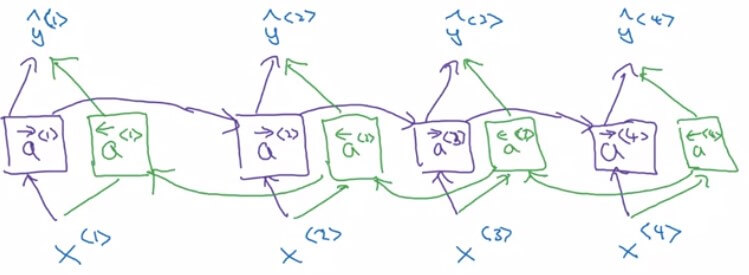 Bidirectional RNN Intuition
Bidirectional RNN Intuition- 為了簡化問題,假設現在只讀了前四個字
He said Teddy Roosevelt - 首先一如往常將句子由左至右產出 a<1>,a<2>,a<3>,a<4> (以 → 表示)
- 接著再將句子由右至左產出 a<4>,a<3>,a<2>,a<1> (以 ← 表示)
- 要注意的是,兩個都是 forward propogation,並非 backpropogation !
- 所以現在要計算句子中任意一個 y^<t> 都可以配合左右兩邊的資訊來計算
- y^<t>=g(Wy[a<t>,a<t>]+by)
- 例如要計算 y^<3> 的 Teddy 為人名的機率
- y^<3>=g(Wy[a<3>,a<3>]+by)
- 他考慮的 a<3> 考慮了 a1, a2 的
He said - 他考慮的 a<3> 考慮了 a4 的
Roosevelt
- BRNN 的缺點是需要完整的句子序列,才可以訓練並預測句子中的任意單字
- 若用在 speech recognition,不可能等所有話講完,再慢慢處理所有文字
- 所以在 speech recognition 的實際應用上,不會使用 standard BRNN
- 但是在能夠一次取得完整句子的 NLP 應用中, standard BRNN 是很有效率的
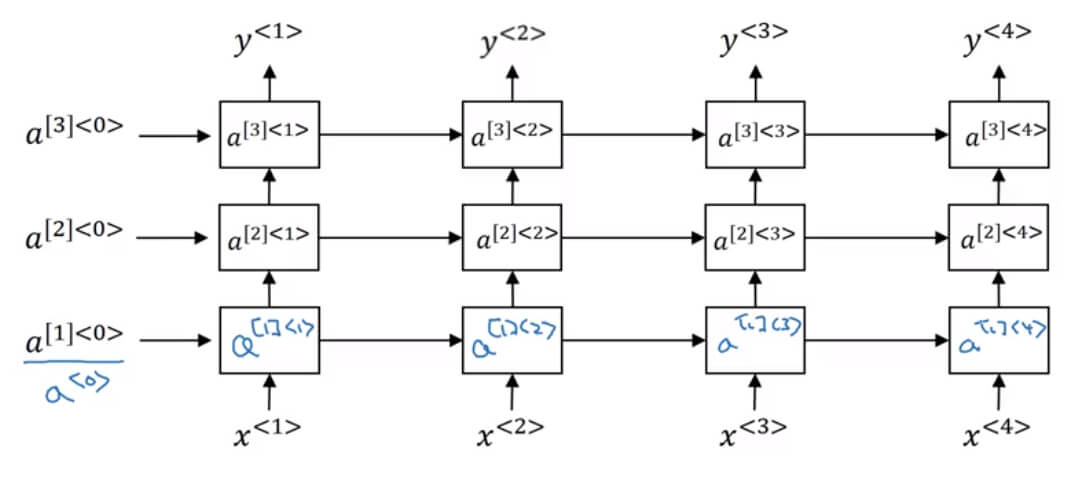 Deep RNN Intuition
Deep RNN Intuition- 到目前為止見到的只是 one hidden layer 的 RNN model
- 事實上 RNN 也可以有多個 hidden layer,只是不會像 CNN 那麼多
- 上圖有幾個 notation 需要解釋
- [l] 用來代表第 l 層
- <t> 用來代表第 t 個 time step
- 所以 a[2]<3> 代表是第 2 個 hidden layer 在第 3 個 timestep 的狀況
- 另外在 parameters 也有不同
- Wa[l] 代表在第 l 層的 Wa
- ba[l] 代表在第 l 層的 ba
- 所以 a[2]<3> 的算法為
a[2]<3>=Wa[2][a[2]<2>,a[1]<3>]+ba[2]
- DRNN 中的每一個 blocks 可以是一般的、GRU、LSTM blocks
- DRNN 在計算 y^<t> 前,也可以先接上一連串的 fully-connected networks
- 因為 RNN 的計算量已經相當龐大,所以 DRNN 的 hidden layers 數目並不會太多






